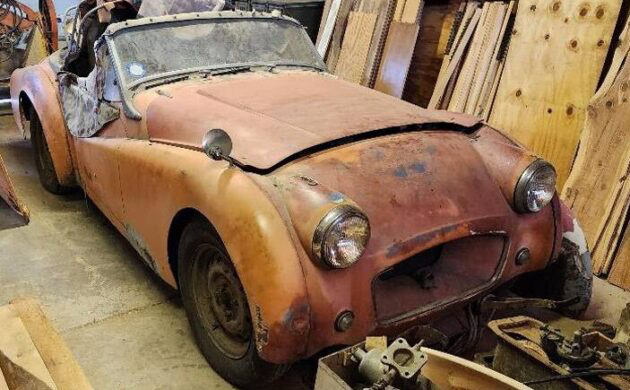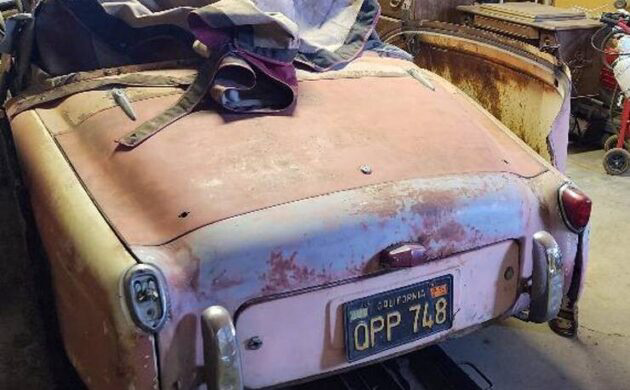The Triumph TR2 was designed to compete against the Morgan, with a list of required ingredients including a roadster body style, simple panel construction, a top speed of at least 90 mph, and a price of no more than £500. Using off-the-shelf- parts from prior production cars, the prototype was completed in 1952. The factory invited Ken Richardson, a prominent test and race driver, to drive the car, and he deemed it completely unfit for prime time. After a substantial redesign, the new car was introduced in 1953. The TR2 was a far cry from its predecessor, the Triumph 2000 Roadster, with spry performance and low-slung coachwork. Here on craigslist is a Triumph TR2 project with an asking price of $5,200. The seller identifies this as a 1952 car, but the first model year was 1953, and this car has “short” doors, which were introduced in 1954. There is no title, so looking at the VIN will be key to finding the year. The car is located near Sierra Vista, Arizona, and it will need a trailer. We have T.J. to thank for this true barn find!
The TR2 was powered by a 1991 cc in-line four-cylinder engine with twin SU carburetors making about 90 bhp. The four-speed manual transmission could be had with overdrive as an option. Top speed exceeded expectations, at just over 100 mph. No photos of this car’s engine bay are supplied, but the seller does say a spare engine, along with numerous other parts including sheet metal, come with the car. The seller says this car does have some rust. The deeply recessed grille is a quick way to tell a TR2 from a TR3.
The interior is rough, even looking past the jumble. At least the top bows, gauges, steering wheel, and other expensive parts are present. The dash should be covered in the same material as the seats. One of the purposes of the redesign of the prototype was to widen the cabin. The result is a fairly accommodative sports car.
The rear of the car shows off the red lens above the license plate; later, that part was switched out for a chrome version that was used on many makes across the ages. The spare tire sleeps behind that panel where the license plate is mounted. On very early cars, this panel as well as the bonnet were aluminum. The TR2 saw many small changes during its two-year production run; undertaking a true restoration revolves around researching the VIN and where it falls in the evolution of the model. Fortunately, these are easy to work on, and any extra parts can be sold off to help fund a restoration. What do you think, would this make a good winter project?






It may be rough, but at least it’s rusty.
These little guys have a lot of support from both parts suppliers and clubs. There’s not too much that’s really hard to source and the engines are wet sleeve so you can buy a complete set in the stock size and have an “original” engine or you can save a few bucks and get the big bore kit (2187cc?). The interiors have a bunch of little bits and parts but overall they’re as close to a reliable little British car as I’ve ever owned. The front fenders and door sills have poor drainage and they all rust there. If I had $5k laying around I’d snap this up, rust and all.
Morgan was never a factor in sales with Triumph. MG was the big prize. The TR was a heavy steering car with so so looks. It never sold as well as the MG. Both companies were not related at the time. I was never a fan of the TR2 3 line. Not much resale value.
Your lack of ‘fandom” shows. MGs were cheaper, in build and value. When was the last time a Midget or MGB sold over $30K? Common with these cars.
I recall these were the first of it’s class to exceed ‘the tonne’ (100 mph) the body looks very straight and since the car has a sturdy frame rust tends to be cosmetic, and as illustrated: the wings(fenders) unbolt so are easily replaced. Looks like a enjoyable project to do while winter does it’s thing–IF YOU HAVE A GARAGE! Being the first of a long line of cherished sports cars, it will be valuable for those that love classic Brit cars!
I had a 1954 TR2 back around 1958 and it had the long door. It could have been a 1953 model sold in 1954 but I would put any short door TR being built after 1954 or 1955.
Cute little thing but It would take a big set to drive this one up to 100 mph, IMHO. Cool project. Good luck and happy motoring!
Cheers
GPC
Put a Buick turbo V6 in it..
” The Triumph TR2 was designed to compete against the Morgan ” – hmm, I’d be interested to see what the author’s source for that statement is?
(…being a TR owner and enthusiast) I thought I’d read pretty much every history or background source about these cars, never heard that one? seems unlikely, Morgan were more of a low production, hand-built niche model, Triumph were more interested in mass sales for the NA market particularly, MG were their target, their competitor. The only real Morgan connection is the fact that Standard-Triumph sold their 4-cylinder engine to Morgan to power their “Plus 4” model.
Very good question. So you know that Standard was providing motors to Morgan in the 1940s. In about 1947, Standard announced that it would develop the Vanguard model, and its motor, and cease production of all else; thus Morgan had to accept whatever was developed for the Vanguard, and that turned out to be a 2088 cc engine. This was not ideal for Morgan, which did not want to be forced to compete in the >2000 cc classes, but they took it anyhow. Meanwhile, Standard had purchased Triumph’s name and trademarks out of bankruptcy in 1944, but hadn’t yet developed a sports car in the Triumph line what with the war and all. Rather than develop its own car, Sir John Black approached Morgan about a merger in 1950. This was rebuffed. According to this author, that rejection provided the motivation for the TR2.
https://www.magzter.com/stories/Automotive/Triumph-World/Standard-Triumph-Powered-Morgans-Part-II-Post-1945
I owned a 53 long door TR2 in 1964 and I bought it from the original owner. The one in the picture has a chrome ring around the mouth that was not on the 2 but was on the early 3. The first three had the same square mouth as the 2.